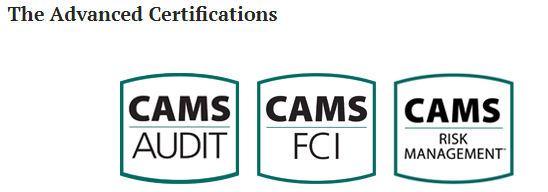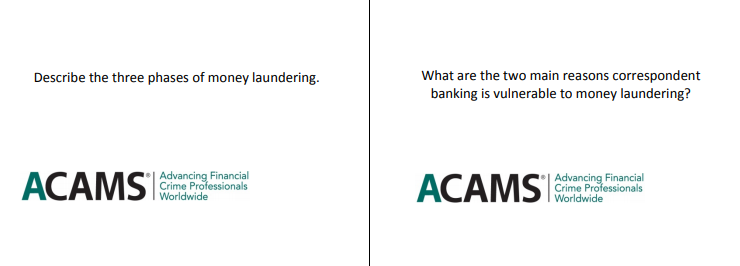If you aim to become a Certified Anti-Money Laundering Specialist (CAMS), you are not just pursuing a credential; you are stepping into a critical role that safeguards the financial world. In 2025, with money laundering techniques evolving faster than ever, financial institutions, fintechs, and regulatory bodies are on high alert. Being CAMS-certified not only validates your knowledge but also demonstrates your ability to identify, investigate, and prevent financial crimes that can destabilize entire markets.
But let’s be real, preparing for the CAMS exam can feel overwhelming. From understanding global AML regulations and transaction monitoring to mastering risk assessments and compliance frameworks, the syllabus is dense and detailed. That’s why having a structured, up-to-date study guide is not just helpful, it’s essential.
In this guide, we will walk you through every critical concept, equip you with strategies to tackle the toughest questions, and provide a roadmap that ensures you don’t just memorize but truly understand the material. Whether you’re a seasoned compliance professional or a motivated newcomer, this guide is your key to cracking the CAMS exam confidently and staying ahead in the fight against financial crime.
Certified Anti-Money Laundering Specialist (CAMS) Exam Overview
The CAMS certification, offered by the Association of Certified Anti-Money Laundering Specialists (ACAMS), is the most recognized credential for professionals in anti-money laundering, financial crime prevention, and compliance. It validates your ability to identify suspicious activities, understand AML regulations, and implement effective compliance programs.
Exam Format
- Number of Questions: 120 multiple-choice questions
- Exam Type: Computer-based
- Duration: 3.5 hours (210 minutes)
- Passing Score: 75% or higher
- Language: English
- Delivery: Can be taken at authorized testing centers or via online proctoring
Eligibility Requirements
To sit for the CAMS exam, you need:
- Professional Experience: Minimum of 40 qualifying experience credits, which usually translates to around 24 months in AML, financial crime prevention, or related compliance roles.
- Educational Background: While a formal degree is not strictly required, most candidates have a bachelor’s degree or higher.
- Membership: Optional, but ACAMS membership provides study resources and practice questions.
Key Skills Tested
- Understanding AML laws, regulations, and compliance frameworks
- Identifying suspicious transactions and patterns
- Developing and implementing effective AML programs
- Reporting obligations and escalation procedures
- Risk assessment and mitigation strategies
The Certified Anti-Money Laundering Specialist (CAMS) exam is for people working in anti-money laundering (AML). It checks if AML professionals have the knowledge and skills to find and stop money laundering, terrorist financing, and other financial crimes. The CAMS test is provided by ACAMS, the biggest worldwide group that helps AML and financial crime experts learn more. This test has 120 questions with multiple choices, and you have four hours to finish it.
Certified Anti-Money Laundering Specialist (CAMS) Exam Glossary
Here are some key terms related to anti-money laundering (AML) and the Certified Anti-Money Laundering Specialist (CAMS) certification:
- Anti-Money Laundering (AML): A set of rules, laws, and steps made to stop, find, and tell on people who try to hide illegal money.
- Money Laundering: Hiding where money or things came from when they were obtained illegally, so they look like they came from legal places.
- Terrorist Financing: The provision of funds or financial support to individuals or groups involved in terrorist activities.
- Financial Crimes Enforcement Network (FinCEN): A part of the U.S. Treasury Department that gathers and studies info about money movements to fight against illegal activities like money laundering, funding terrorists, and other financial crimes.
- Customer Due Diligence (CDD): The process of verifying the identity of customers and assessing the risks associated with their transactions in order to prevent money laundering.
- Enhanced Due Diligence (EDD): A more rigorous form of due diligence that involves additional measures to verify the identity of high-risk customers and mitigate the risks associated with their transactions.
- Suspicious Activity Report (SAR): A report filed by financial institutions to FinCEN when they suspect that a transaction may involve money laundering or other financial crimes.
- Office of Foreign Assets Control (OFAC): A part of the U.S. Treasury Department that handles and makes sure that specific rules about trade and money don’t get broken by certain foreign countries, people, or groups.
- Know Your Customer (KYC): A set of rules that banks and similar places have to follow. They need to check who their customers are and see if the money moves they make are safe or risky.
- CAMS Certification: A globally recognized certification awarded by the Association of Certified Anti-Money Laundering Specialists (ACAMS) to professionals who demonstrate a comprehensive understanding of AML principles and practices.
Certified Anti-Money Laundering Specialist (CAMS) Study Guide
Here are some official resources for the Certified Anti-Money Laundering Specialist (CAMS) exam:
- ACAMS Website: The Association of Certified Anti-Money Laundering Specialists (ACAMS) is the organization that administers the CAMS certification. Their website provides information on the certification process, exam content, and study materials.
- CAMS Exam Preparation: ACAMS offers a variety of resources to help candidates prepare for the CAMS exam, including study materials, online courses, and practice exams.
- CAMS Study Guide: The CAMS study guide is a big helper that talks about everything you need to know for the test. It has practice questions, real-life stories, and lots of useful stuff.
- CAMS Examination Handbook: The CAMS examination handbook provides detailed information on the exam format, scoring, and other important aspects of the testing process.
- CAMS Exam Syllabus: The CAMS exam syllabus outlines the topics and concepts that are covered on the exam, as well as the percentage of questions that are devoted to each topic.
- ACAMS Webinars: ACAMS offers a series of webinars that cover various AML topics and can help candidates prepare for the CAMS exam.
- CAMS Practice Exam: ACAMS gives you a practice test that’s like the real CAMS test. It helps you see what you know and where you need to get better.
All of these resources can be found on the ACAMS website at www.acams.org.
Certified Anti-Money Laundering Specialist (CAMS) Exam Tips and Tricks
Here are some tips and tricks for preparing and taking the Certified Anti-Money Laundering Specialist (CAMS) exam:
- Start with the basics: Before you start learning the harder topic, make sure you really understand the basic things about anti-money laundering rules, laws, and the best ways to do it.
- Create a study plan: Develop a study plan that includes a realistic timeline and covers all of the topics that will be tested on the exam. Make sure to allocate enough time to review and practice.
- Use a variety of study materials: There are many resources available to help you prepare for the CAMS exam, such as textbooks, online courses, and practice exams. Utilize a variety of study materials to ensure a comprehensive understanding of the topics.
- Familiarize yourself with the exam format: The CAMS test is done on a computer and has multiple choice questions where you choose from different options. Get used to how it looks and practice with similar tests to get better at doing it quickly and accurately.
- Focus on key concepts and terms: Pay attention to key concepts, terms, and definitions throughout your studies. This will help you better understand the material and be able to answer questions more accurately.
Learning Path: Certified Anti-Money Laundering Specialist
In 2001, ACAMS started a mission to create a global measure for testing the understanding of people responsible for stopping money laundering. They also developed advanced certifications like CAMS-Audit, CAMS-FCI, and CAMS-Risk Management, which provide high-level training to professionals. These certifications give them important knowledge about anti-money laundering and help them meet the rules and expectations of regulators in areas like auditing, investigating financial crimes, and managing risks.

Certified Anti-Money Laundering Specialist Preparation Guide 2025
The key to crack any exam is by preparing with the right resources and along with the correct learning path. Preparing for the exam requires consistency and determination. We present you our specially curated CAMs exam Study Guide to help you achieve this certification in the very first attempt. Let’s discuss step by step guide to facilitating your preparation.

Step 1- Review the Exam Objectives
The first step is to visit the Official Site and review all the exam objectives. Familiarising yourself with exam courses and concepts is indeed important before venturing into the exam preparations. Devote enough time to each topic and have an in-depth knowledge of the subject. The Certified Anti Money Laundering Specialist exam covers the following 4 domains-
- Firstly, Risks and methods of money laundering and terrorism financing (26%)
- Secondly, Compliance standards for anti-money laundering and combating the financing of terrorism (25%)
- Then, Anti-money laundering, CFT and sanctions compliance programs (28%)
- Also, Conducting or supporting anti-money laundering investigations (21%)
Step 2- Discover Learning Resources
There are abundant study resources available for the exam. Further, you must remember to refer to appropriate learning sources. It is suggested to choose the learning curve that best suit your preparations. Here are some Learning Resources you must explore-
Flashcards
Studying flashcards will test the candidate’s knowledge about the CAMS exam with quiz-style printable flashcards. Also, these study flashcards highlight the most critical learning points from the CAMS study guide.

CAMS Virtual Classroom
Now, this becomes the most significant part of any preparation guide. As a result, ACAMS also provides the candidates with the CAMS Virtual Classroom. This includes access to six 2-hour continuous web-based programs which serves to structure and strengthen your preparation. Moreover, it offers In-depth analysis of the content covered in the CAMS Guide. Learn through the CAMS Virtual Classroom to enhance your preparations.
Step 3- Self-Evaluate with Practice Test
Practice tests are really significant to check your preparations. They provide you with insights into your strengths and weaknesses. Strengthening your weakness will help you ace the exam. Also, attempt as many practice papers as you can and try to perform better than the previous one each time. There are plenty of practice papers available online. Make sure you choose the right and authentic ones. Start using CAMs exam practice tests Now and crack the exam!
How to Prepare for the Certified Anti-Money Laundering Specialist (CAMS) Exam?
Preparing for the CAMS exam isn’t just about memorizing definitions—it’s about understanding the principles, regulations, and practical applications of anti-money laundering. A systematic approach can make your preparation efficient and effective, especially for professionals with some AML experience. Here’s a roadmap:
Step 1: Understand the Exam Structure
Before diving into study materials, familiarize yourself with the exam format, domains, and question types. Knowing what to expect reduces surprises and helps focus on high-weighted areas.
Step 2: Gather Study Materials
Use authoritative and up-to-date sources. The ACAMS CAMS Review Manual is your primary guide, but supplement it with online courses, practice questions, webinars, and real-life case studies.
Step 3: Create a Structured Study Approach
Focus on understanding concepts rather than rote memorization. Divide your preparation into sections aligned with the exam domains, and practice applying knowledge to real-world AML scenarios.
Step 4: Practice, Review, and Assess
Regular practice using mock exams and scenario-based questions is essential. Review incorrect answers carefully to identify knowledge gaps, and reinforce weaker areas before exam day.
CAMS Exam Preparation Strategy
| Focus Area | Preparation Tips | Recommended Resources | Time Allocation |
|---|---|---|---|
| AML Fundamentals (30%) | Understand money laundering stages, global AML regulations, and risk-based approaches. | CAMS Review Manual (Ch. 1-3), ACAMS webinars, regulatory updates | 25-30% of total study time |
| AML Compliance Standards (25%) | Learn to design AML programs, implement controls, and ensure reporting compliance. | CAMS Manual (Ch. 4-6), case studies, ACAMS online courses | 20-25% of study time |
| Operational Practices (25%) | Master customer due diligence (CDD), transaction monitoring, enhanced due diligence (EDD), and suspicious activity reporting. | CAMS Manual (Ch. 7-9), practice questions, industry examples | 20-25% of study time |
| Investigation & Enforcement (20%) | Focus on AML trends, typologies, sanctions screening, and collaboration with law enforcement. | CAMS Manual (Ch. 10-12), case studies, ACAMS forums | 15-20% of study time |
| Practice Tests & Mock Exams | Regularly attempt full-length practice exams to simulate exam conditions and identify weak areas. | ACAMS practice questions, online mock exams | Final 10-15% of preparation |
Additional Tips for Experienced Professionals
- Leverage Your Work Experience: Connect real-world AML cases you’ve encountered to exam concepts.
- Stay Updated on Regulations: 2025 updates may include new sanctions, FATF guidelines, and AML trends—keep up with ACAMS alerts and industry publications.
- Join Study Groups: Engaging with peers helps clarify doubts, share insights, and discuss complex scenarios.
- Focus on Weak Areas: Use practice test results to prioritize challenging domains.



